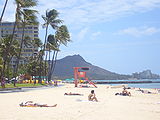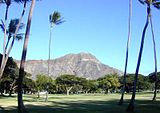- Diamond Head, Hawaii
-
Diamond Head
Diamond Head cone seen from Round Top RoadElevation 762 ft (232 m) Location Location Honolulu, Hawaiʻi, USA Range Hawaiian Islands Coordinates 21°15′35.0″N 157°48′42.3″W / 21.25972°N 157.81175°W Topo map USGS Honolulu Geology Type Volcanic cone Age of rock 200,000 years Climbing Easiest route Trail Diamond Head is the name of a volcanic tuff cone on the Hawaiian island of Oʻahu and known to Hawaiians as Lēʻahi, most likely from lae 'browridge, promontory' plus ʻahi 'tuna' because the shape of the ridgeline resembles the shape of a tuna's dorsal fin.[1] Its English name was given by British sailors in the 19th century, who mistook calcite crystals embedded in the rock for diamonds.
Contents
Geology
Diamond Head is part of the complex of cones, vents, and their associated eruption flows that are collectively known to geologists as the Honolulu Volcanic Series, eruptions from the Koʻolau Volcano that took place long after the volcano formed and had gone dormant. The Honolulu Volcanic Series is a series of volcanic eruption events that created many of Oʻahu's well-known landmarks, including Punchbowl Crater, Hanauma Bay, Koko Head, and Mānana Island in addition to Diamond Head.
Diamond Head, like the rest of the Honolulu Volcanics, is much younger than the main mass of the Koʻolau Mountain Range. While the Koʻolau Range is about 2.6 million years old, Diamond Head is estimated to be about 150,000 years old and extinct for 150,000 years.
The eruption that built up Diamond Head was probably very brief, lasting no more than a few days. It was probably explosive, since when the cinder cone was originally formed, the sea level is thought to have been higher and the vent burst erupted over a coral reef. Another factor probably contributing to the eruption's explosive nature was that rising magma would have come into contact with the water table. The eruption's relatively brief length is thought to explain why the cone today is so symmetrical.
A nearby eruption that took place at about the same time as the Diamond Head eruption was the eruption that built the Black Point lava shield. Since the type of eruptions that built Diamond Head tend to be monogenetic, geologists don't believe Diamond Head will erupt again.


Diamond Head, Punchbowl Crater and Honolulu from Na Pueo park Tourism and fame
Diamond Head is a defining feature of the view known to residents and tourists of Waikiki alike. The volcanic tuff cone is a United States State Monument. While part of it serves as a platform for antennas used by the U.S. government and is closed to the public, the crater's proximity to Honolulu's resort hotels and beaches makes the rest of it a popular destination.
A 0.75-mile (1.1-km) hike leads to the edge of the crater's rim. Signs at the trailhead say that the hike takes 1.5–2 hours round-trip, and recommends that hikers bring water. Although not difficult, the signs also say that the hike is not a casual one: the mostly unpaved trail winds over uneven rock, ascends 74 steps, then through a tunnel and up another steep 99 steps. Next is a small lighted tunnel to a narrow spiral staircase (about 30 steps) inside a coastal artillery observation platform built in 1908. From the summit above the observation platform both Waikiki and the Pacific Ocean can be seen in detail.
The volcano is a symbol of the worldwide recognition of the Hawaiian Islands; because of this, Diamond Head is widely used for commercial purposes (see Diamond Head (film) and Diamond Head (band)). Many souvenirs from Hawaii and surf shop logos around the world bear the volcano's distinctive silhouette.
Interior
The interior was the home to Fort Ruger, the first United States military reservation on Hawaii. Only a National Guard facility remains in the crater. An FAA air traffic control center was in operation from 1963 to 2001.[2]
Television show
There was a 1975 televised game show, The Diamond Head Game set at Diamond Head. The host was the game show main-stay, Bob Eubanks. Final contestants could step into a "Money Volcano" and catch flying bills of real money.[3]
Other references
Areas of Diamond Head were also used while filming the television series Lost which was filmed entirely on location on the island of Oʻahu. Parts of the old Army base were featured in Lost as an Iraqi Prison and a Scottish military camp. The biannual Transpac race (held in July of odd-numbered years), finishes off of Diamond Head. "Diamond Head" is the name of a song on the album entitled "Friends" by American pop group The Beach Boys. Diamond Head is the name of an album by Anglo-Argentinian musician Phil Manzanera.
- Various views of Diamond Head
-
View from Halekulani Hotel
-
View from Punchbowl Crater in Winter
-
View from Rocky Hill, which resides over Punahou School
-
Diamond Head peak from Kapiolani Park
-
Waikiki Beach facing Diamond Head, 1958
See also
References
- ^ Mary Kawena Pukui, Samuel H. Elbert, Esther K. Mookini, eds. (1974). Place Names of Hawaii, revised and expanded edition. Honolulu: University of Hawaiʻi Press. ISBN 0824805240.
- ^ FAA presence inside Diamond Head vanishes, Suzanne Roig, Honolulu Advertiser, September 28, 2001.
- ^ "The Diamond Head Game" (1975)
External links
Protected Areas of Hawaii Federal Hakalau Forest • Hanalei • Hawaiian Islands • Huleia • James Campbell • Kakahaia • Kealia Pond • Kilauea Point • Kona Forest • Oahu ForestState Parks,
Monuments
Recreation Areas
and PreservesAkaka Falls State Park · Hapuna Beach State Recreation Area · Kalopa State Recreation Area · Kealakekua Bay State Historical Park · Kohala Historical Sites State Monument · Kona Coast (Kekaha Kai) State Park · Lapakahi State Historical Park · Lava Tree State Monument · MacKenzie State Recreation Area · Manuka State Wayside · Mauna Kea Ice Age Reserve · Mauna Kea State Recreation Area · Old Kona Airport State Recreation Area · Wailoa River State Recreation Area · Wailuku River State ParkKaua‘iMoloka‘iO‘ahuAhupua'a O Kahana State Park · 'Aiea Bay State Recreation Area · Diamond Head State Monument · Hanauma Bay Nature Preserve · He‘eia State Park · ‘Iolani Palace State Monument · Ka'ena Point State Park · Kaka'ako Waterfront Park · Kea'iwa Heiau State Recreation Area · Kewalo Basin · Kukaniloko Birthstones State Monument · La'ie Point State Wayside · Makapu‘u Point State Wayside · Malaekahana State Recreation Area · Nu'uanu Pali State Wayside · Pu'u o Mahuka Heiau State Monument · Pu'u 'Ualaka'a State Wayside · Royal Mausoleum State Monument · Sacred Falls State Park · Sand Island State Recreation Area · Ulu Pō Heiau State Monument · Wa'ahila Ridge State Recreation Area · Wahiawa Freshwater State Recreation AreaCategories:- Landforms of Oahu
- Headlands of Hawaii
- Tuff cones
- Volcanoes of Oahu
- Hotspot volcanoes
- Extinct volcanoes
- National Natural Landmarks in Hawaii
- Pleistocene volcanoes
Wikimedia Foundation. 2010.














